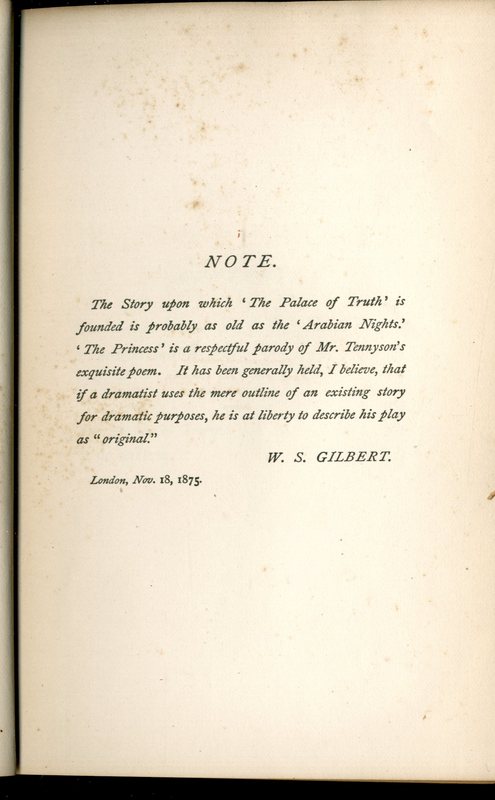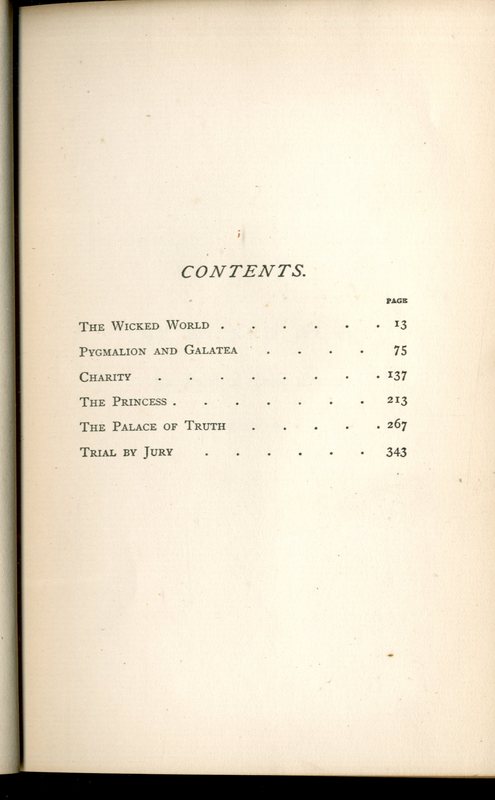Original plays (Still Image)
Dublin Core
Title:
Description:
366 p
Abstract:
Sir William Schwenck Gilbert (1836 – 1911) was an English dramatist, librettist, poet and illustrator best known for the fourteen comic operas (known as the Savoy operas) produced in collaboration with the composer Sir Arthur Sullivan. The most famous of these include H.M.S. Pinafore, The Pirates of Penzance and one of the most frequently performed works in the history of musical theatre, The Mikado.These, as well as several of the other Savoy operas, continue to be frequently performed in the English-speaking world and beyond by opera companies, repertory companies, schools and community theatre groups.
http://en.wikipedia.org/wiki/W._S._Gilbert
This volume contains a selction of his plays
The Wicked World is a blank verse play by W. S. Gilbert in three acts. It opened at the Haymarket Theatre on 4 January 1873 and ran for a successful 145 performances, closing on 21 June 1873. The play is an allegory loosely based on a short illustrated story of the same title by Gilbert, written in 1871 and published in Tom Hood's Comic Annual, about how pure fairies cope with a sudden introduction to them of "mortal love."
Set in "Fairy Land", the action occurs within the space of 24 hours. Gilbert envisioned the set as resembling John Martin's 1853 painting The Plains of Heaven: vaporous mountains and headlands around ethereal blue and a flowering slope on which sit white-clad angels. Gilbert also specified that the women characters 'in costume & general appearance – should suggest the idea rather of angels than of conventional fairies, and they exhibit an 'overweening sense of righteousness,' arising from their freedom from sin.
http://en.wikipedia.org/wiki/The_Wicked_World
Pygmalion and Galatea is a blank verse play by W. S. Gilbert in three acts based on the Pygmalion story. It opened at the Haymarket Theatre in London on 9 December 1871 and ran for a very successful 184 performances. In Gilbert's Pygmalion story, the sculptor is a married man. He sculpts many copies in the image of wife, Cynisca. His wife at first encourages his interest in one of these statues, Galatea. Cynisca is often away, and she doesn't want her husband to be bored. When the statue comes to life, however, matters become complex, as she falls in love with her creator. Galatea is born so innocent that she appears wayward and disrupts the lives she touches during her one day in the flesh. Under the fire of Cynisca's jealousy, and seeing the difficulty in which she has placed Pygmalion, Galatea decides that her original state was happier, and turns back into a statue.
http://en.wikipedia.org/wiki/Pygmalion_and_Galatea
Charity s a drama in four acts by W. S. Gilbert that explores the issue of a woman who had lived with a man as his wife without ever having married. The play analyses and critiques the double standard in the Victorian era concerning the treatment of men and women who had sex outside of marriage, anticipating the "problem plays" of Shaw and Ibsen. It opened on 3 January 1874 at the Haymarket Theatre in London, where Gilbert had previously presented his 'fairy comedies' The Palace of Truth, Pygmalion and Galatea, and The Wicked World. Charity ran for about 61 performances, closing on 14 March 1874, and received tours and revivals thereafter.
http://en.wikipedia.org/wiki/Charity_(play)
The Princess is a blank verse farcical play, in five scenes with music, by W. S. Gilbert which adapts and parodies Alfred Lord Tennyson's humorous 1847 narrative poem, The Princess: A Medley. It was first produced at the Olympic Theatre in London on 8 January 1870.
Gilbert called the piece "a whimsical allegory ... a respectful operatic per-version" of Tennyson's poem. The play was a modest success, playing for about 82 performances through April and enjoying a provincial tour. Gilbert liked the theme so much that he adapted the play as the libretto to Princess Ida (1884), one of his Savoy Operas with Arthur Sullivan. The Princess is a satire of women's education, a controversial subject in 1847, when Queen's College first opened in London, and in 1870 (Girton opened in 1869), but less so by 1884.
http://en.wikipedia.org/wiki/The_Princess_(W._S._Gilbert_play)
The Palace of Truth is a three-act blank verse "Fairy Comedy" by W. S. Gilbert first produced at the Haymarket Theatre in London on 19 November 1870, partly adapted from Madame de Genlis's fairy story, Le Palais de Vérite. The play ran for approximately 140 performances and then toured the British provinces and enjoyed various revivals even well into the 20th century. There was also a New York production in 1910.
http://en.wikipedia.org/wiki/The_Palace_of_Truth
Trial By Jury is a comic opera in one act, with music by Arthur Sullivan and libretto by W. S. Gilbert. It was first produced on 25 March 1875, at London's Royalty Theatre, where it initially ran for 131 performances and was considered a hit, receiving critical praise and outrunning its popular companion piece, Jacques Offenbach's La Périchole. The story concerns a "breach of promise of marriage" lawsuit in which the judge and legal system are the objects of lighthearted satire. Gilbert based the libretto of Trial by Jury on an operetta parody that he had written in 1868.
http://en.wikipedia.org/wiki/Trial_by_Jury
Published also by Chatto & Windus with, Iolanthe added, as his Original plays, first series"
The wicked world.--Pygmalion and Galatea.--Charity.--The princess.--The palace of truth.--Trial by jury"
Date:
1876
Subject:
Identifier:
b32650644
PR4713 .A12 1876
Publisher:
Has Version:
Collection:
Embed
Copy the code below into your web page


